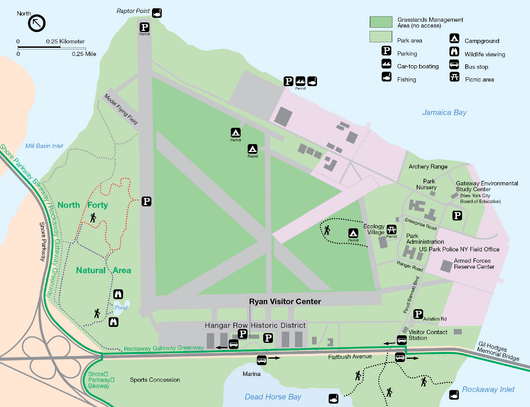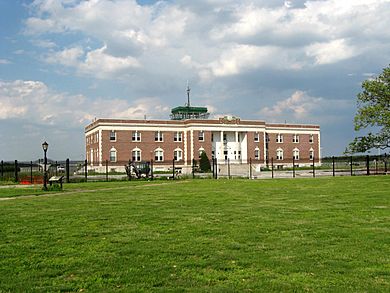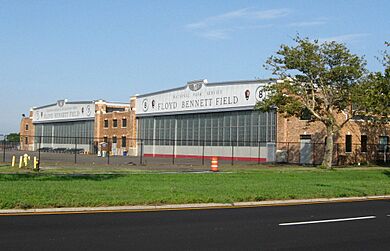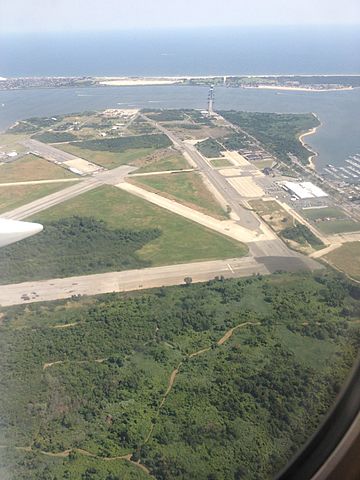Floyd Bennett Field facts for kids
Quick facts for kids |
|
|
Floyd Bennett Field Historic District
|
|

Floyd Bennett Field in 2006
|
|
| Location | Flatbush Avenue, Brooklyn, New York |
|---|---|
| Built | 1928–1930 |
| Architect | Department of Docks |
| Architectural style | |
| NRHP reference No. | 80000363 |
| Added to NRHP | April 11, 1980 |
Floyd Bennett Field is a historic airfield in Brooklyn, New York City. It sits along the shore of Jamaica Bay. This airport was once a busy place for commercial and private planes. Later, it became a naval air station for the military.
Today, Floyd Bennett Field is part of the Gateway National Recreation Area. The National Park Service (NPS) takes care of it. While planes don't take off and land here like they used to, a part of it is still a helicopter base for the New York City Police Department (NYPD). One runway is even used by hobbyists who fly radio-controlled aircraft.
Floyd Bennett Field was built by connecting several small islands to Brooklyn. Workers filled the water channels with sand from Jamaica Bay. The airport was named after Floyd Bennett, a famous pilot. He was one of the first to fly over the North Pole. Bennett had dreamed of an airport on Barren Island before he passed away in 1928. Construction on the field began that same year.
The airport officially opened on May 23, 1931. Even though it had great facilities, it didn't get many commercial flights. Instead, it became famous for private planes and record-breaking flights. Many pilots set new aviation records flying to or from Floyd Bennett Field.
In the 1930s, the United States Coast Guard and United States Navy started using parts of the airport. When World War II began, it became a major naval air station. After the war, it remained a Navy base for reserve pilots. In 1970, the Navy left, and the Coast Guard stayed until 1998.
After the military left, people wondered what to do with the airport. It was too close to John F. Kennedy International Airport for regular civilian flights. In 1972, it was decided to make it part of the Gateway National Recreation Area. Floyd Bennett Field reopened as a park in 1974.
Many of the old buildings are now part of a historic district. They show what early commercial aviation architecture looked like. The field also has natural areas, a campground, and wide grasslands.
Contents
- History of Floyd Bennett Field
- What You Can Find at Floyd Bennett Field
- What's Happening Now
- Famous Flights from Floyd Bennett Field
- Getting to Floyd Bennett Field
History of Floyd Bennett Field
Why New York City Needed an Airport
Floyd Bennett Field was New York City's very first city-owned airport. It was built because air travel became more popular after World War I. In the 1920s, other cities had municipal airports, but New York City mostly had private ones.
By the late 1920s, New York City really needed its own airport. Nearby Newark Liberty International Airport opened in 1928. Famous pilots like Charles Lindbergh were making transatlantic flights from the New York area. Most air traffic then was for airmail. Newark Airport became the main airmail hub for the region. New York City leaders wanted an airport within the city to be a part of the aviation world.
Choosing the Best Location
In 1927, a special committee looked for places to build an airport. They suggested a few spots, and an existing airstrip on Barren Island was a top choice. A pilot named Paul Rizzo already had a small private airport there.
Barren Island was chosen for several reasons. The city already owned the land. There were no tall buildings nearby, which was good for planes. Also, Jamaica Bay was right there, so seaplanes could use the airport too. Some people worried about fog, but officials said it wasn't a big problem.
Building the Airport
In 1928, the city approved building the airport on Barren Island. They set aside 380 acres of land. Workers filled in the channels between islands with sand from Jamaica Bay. This made the land higher and flatter.
The airport was renamed after Floyd Bennett in October 1928. Bennett was a hero who had flown over the North Pole. He had even said that an airport should be built on Barren Island. Sadly, he passed away in April 1928 during a rescue mission.
Workers built two concrete runways. One was 3,110 feet long, and the other was 4,000 feet long. The longer one was the longest concrete runway in the U.S. at the time. These runways were very advanced for their day. They also planned for an administration building and eight hangars.
Grand Opening and Early Days
The airport had a dedication ceremony on June 26, 1930. About 25,000 people came to see an air show led by Charles Lindbergh. The airport officially opened on May 23, 1931.
In its first year, Floyd Bennett Field saw many flights. It even became a popular spot for transatlantic flights. By 1933, it had more flights than Newark Airport. It was the second busiest airport in the U.S. that year.
Why Commercial Flights Didn't Stay
Floyd Bennett Field never became a big commercial success. It was too far from Manhattan, New York City's main business center. Also, it couldn't get the profitable airmail contracts, which went to Newark Airport. Airmail was a big part of airport income back then.
Only one airline, American Airlines, regularly flew from Floyd Bennett Field for a short time. Most planes that landed there were likely diverted from Newark.
A Hub for Record Breakers
Even without commercial success, Floyd Bennett Field became famous. It was a perfect place for pilots trying to break records. Its modern facilities, clear skies, and location near the Atlantic Ocean made it ideal. Many "firsts" and speed records were set here. Pilots also took flying lessons at the field.
The city eventually built LaGuardia Airport in Queens, which was much closer to Manhattan. Commercial flights at Floyd Bennett Field stopped in 1939. The Navy took over the airport in 1941.
Military and Police Use
The United States Navy Reserve started using Floyd Bennett Field in 1931. The New York City Police Department (NYPD) also set up the world's first police aviation unit here in 1934. In 1936, the United States Coast Guard opened its own air station at the field.
As World War II grew more intense, the Navy wanted to expand. In 1941, the airport closed to all civilian flights. On June 2, 1941, it officially became Naval Air Station New York.
Floyd Bennett Field During World War II
During World War II, NAS New York was a very busy place. It hosted many Navy units. Planes from here patrolled the Atlantic coast, looking for German submarines. It was also a training facility and a place to load supplies for Navy officers. Women in the Navy, called WAVES, worked as air traffic controllers and mechanics. Over 20,000 new aircraft were delivered here during the war.
The Coast Guard also worked with the Navy, patrolling New York Harbor and training soldiers.
After World War II
After World War II, many military bases were downsized. Floyd Bennett Field became a Naval Air Reserve station. The NYPD Aviation Unit returned to the base.
There were ideas to use Floyd Bennett Field for commercial flights again. But the Navy and the Port Authority couldn't agree on costs. So, commercial flights never returned. The Navy continued to use it as a training base for reservists.
Becoming a National Park
By 1970, the Navy decided to close its operational airfield at Floyd Bennett Field. New York City's mayor wanted to turn it into a commercial airport. The state governor proposed a huge development with housing and shops. However, U.S. President Richard Nixon supported a different idea: turning it into a national park.
In September 1972, the United States House of Representatives approved creating the Gateway National Recreation Area. Most of Floyd Bennett Field became part of this new park. It officially opened as a park in 1974.
Floyd Bennett Field Today
In its early years as a park, not many people visited Floyd Bennett Field. But things changed. In 2006, some of the old hangars were turned into the Aviator Sports and Events Center. This is a huge sports complex with ice skating rinks, a gym, and sports fields.
Floyd Bennett Field has also helped during disasters. After the American Airlines Flight 587 crash in 2001, a hangar was used as a temporary morgue. After Hurricane Sandy in 2012, part of a runway became a staging area for relief workers.
In August 2023, a temporary shelter for migrants opened at Floyd Bennett Field.
What You Can Find at Floyd Bennett Field
Floyd Bennett Field covers over 1,000 acres in southeast Brooklyn. It's about 20 miles from Midtown Manhattan. The field is on the east side of Flatbush Avenue, next to Rockaway Inlet. The National Park Service manages land on both sides of the avenue.
The original airport area has eight hangars, an administration building, and five runways. These buildings look much like they did when they were first built. The park is divided into different zones: a "Natural Area" for wildlife, a "Developed Area" for the historic buildings, and an "Administrative Area" for current operations.
West of Flatbush Avenue, there's a golf driving range and a marina.
Floyd Bennett Field also has public camping with 46 campsites. There's a "Grassland Management Area" in the center, which is closed to the public to protect nature. An "Ecology Village" at the south end hosts middle-school students for environmental education. You can also find an archery range, softball and baseball fields, and a racetrack for remote-controlled cars. The NYPD, New York City Department of Sanitation (DSNY), and United States Park Police (USPP) all have facilities here.
The airport's old code was NOP, but now the NYPD heliport uses NY22.
The Administration Building
The administration building is a two-story building with a four-story observation tower. It's now called the William Fitts Ryan Visitor Center, or Ryan Center. It's the main entrance to Floyd Bennett Field. It used to be the airport's passenger terminal and office building. You can visit parts of it, including the old control tower.
The building has a classic look, with red and black bricks and white stone details. This style was common in train stations and post offices back then. It was meant to make passengers feel comfortable, as flying was still new to many people.
The building originally had a restaurant, cafeteria, post office, and a visitor's lounge. It also had offices for the National Weather Service. The inside has an Art Deco style with simple marble panels.
A large community garden is located south of the Ryan Center. It's the biggest community garden in New York City, with about 480 plots.
The Hangars
The original hangars are called "Hangar Row" and are numbered 1 through 8. They are all very similar in design, with buff and brown bricks and steel frames. Each hangar had a large interior space for planes.
In 2006, hangars 5–8 were combined to create the Aviator Sports and Events Center. This huge complex has ice skating rinks, a field house, a gymnastics center, and a fitness center. Outside, there are two turf football fields where hangars 9 and 10 used to be.
Along the Jamaica Bay coast, there's a former Coast Guard hangar built in 1937. It has white stucco walls and a curved roof. The Navy also built two large hangars, A and B, for flying boats. Hangar A was taken down, but Hangar B is still there. Volunteers from the Historic Aircraft Restoration Project keep old planes in Hangar B. These planes are like the ones that used to fly from the airfield.
Runways for Fun
Floyd Bennett Field has five concrete runways. Two were built in 1929, two more in the 1930s, and another in 1942. These runways are no longer used for air traffic.
Today, visitors use the runways for fun activities like flying radio-controlled aircraft, land sailing, and cycling. One area is specifically for flying model airplanes. The NYPD Aviation Unit still uses a section of one runway for helicopter operations.
Natural Areas and Camping
The Goldenrod and Tamarack Campgrounds are near Hangar B. This is the only legal campground in New York City. It's a "primitive" campground, meaning it has portable toilets and no electricity.
The park also has important grasslands. The Grasslands Restoration And Management Project (GRAMP) works to protect these areas. The "Ecology Village" is a triangle-shaped area with hundreds of pine trees. It hosts environmental education programs for students.
The North Forty Natural Area is on the northern side of the airport. It has hiking trails, woodlands, and a pond.
What's Happening Now
Floyd Bennett Field is a busy place with many different uses:
- The New York City Police Department (NYPD) has its aviation base and Emergency Service Unit headquarters here. Their Driver Training Unit also uses a former runway.
- The New York City Department of Sanitation Training Center uses Tylunas Hall and part of a runway for driver training.
- The United States Park Police (USPP) has a station here, covering the New York areas of the Gateway National Recreation Area.
- The Civil Air Patrol's Floyd Bennett Composite Squadron meets at the airfield.
- The 6th Communication Battalion of the United States Marine Corps Reserve is located on the south side of the field.
- The field hosts an annual cycling race series.
- A shelter for migrants and asylum-seekers opened at Floyd Bennett Field in August 2023.
Famous Flights from Floyd Bennett Field
Floyd Bennett Field was a popular spot for famous pilots in the 1930s. Its good weather, location, and modern facilities made it ideal for breaking records. Many pilots started or ended their record-setting journeys here.
- In 1931, Russell Norton Boardman and John Louis Polando flew from Floyd Bennett Field to Istanbul, Turkey. They set a straight-line distance record of 5,011.8 miles!
- Howard Hughes and his crew used Floyd Bennett Field in July 1938. They flew around the world in just 3 days, 19 hours, and 8 minutes. A crowd of 25,000 people cheered when he returned.
- One of the most talked-about flights was by Douglas Corrigan in 1938. He was denied permission to fly non-stop to Ireland. But he "accidentally" flew across the Atlantic anyway, claiming his compass was broken. People called him "Wrong Way" Corrigan, and he became a hero during the Great Depression.
- Wiley Post used the field for his record-breaking flights around the world. He was the first person to fly solo around the world in 1933.
- Famous female pilots like Jacqueline Cochran, Laura Ingalls, and Amelia Earhart also broke records at this airfield.
- In 1957, John Glenn, who later became an astronaut, set a transcontinental air speed record. He flew an F8U-1P Crusader jet from California to Floyd Bennett Field in just 3 hours, 23 minutes, and 8 seconds.
The last record-breaking flights from Floyd Bennett Field happened in May 1969. British Royal Navy F-4K Phantom jets set three speed records for flights from New York to London.
Getting to Floyd Bennett Field
Public Transport
The Q35 local bus serves Floyd Bennett Field on Flatbush Avenue. It connects to the Rockaway Park–Beach 116th Street subway station (A S trains) and the Flatbush Avenue–Brooklyn College subway station (2 and 5 train).
Road Access
You can reach Floyd Bennett Field by car using the Belt Parkway. Take the Flatbush Avenue exit. Flatbush Avenue also connects to the Marine Parkway–Gil Hodges Memorial Bridge, which leads to Jacob Riis Park.
Cycling Access
Cyclists and walkers can get to Floyd Bennett Field using the Jamaica Bay Greenway and the Brooklyn Waterfront Greenway.






